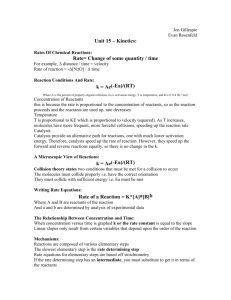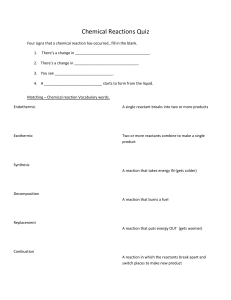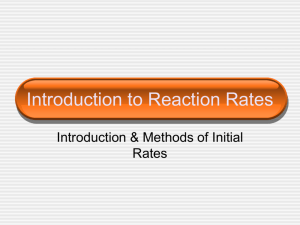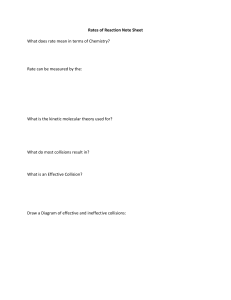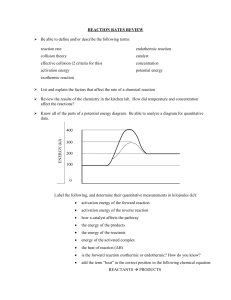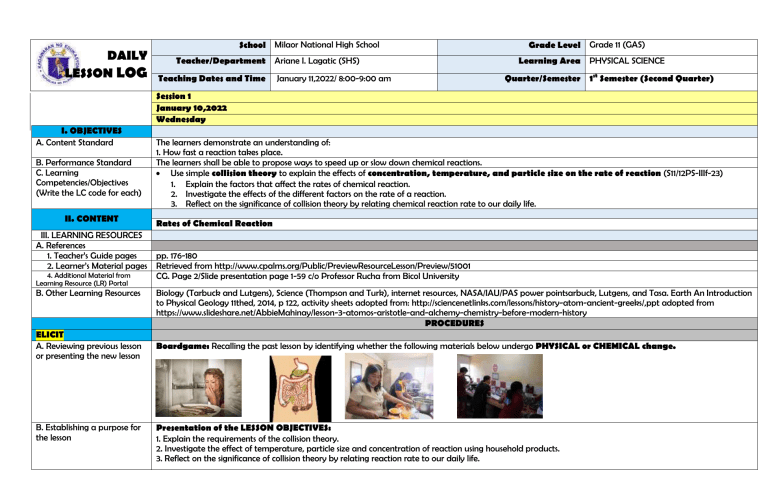
DAILY LESSON LOG School Milaor National High School Teacher/Department Ariane I. Lagatic (SHS) Teaching Dates and Time January 11,2022/ 8:00-9:00 am Grade Level Grade 11 (GAS) Learning Area PHYSICAL SCIENCE Quarter/Semester 1st Semester (Second Quarter) Session 1 January 10,2022 Wednesday I. OBJECTIVES A. Content Standard B. Performance Standard C. Learning Competencies/Objectives (Write the LC code for each) The learners demonstrate an understanding of: 1. How fast a reaction takes place. The learners shall be able to propose ways to speed up or slow down chemical reactions. Use simple collision theory to explain the effects of concentration, temperature, and particle size on the rate of reaction (S11/12PS-IIIf-23) 1. Explain the factors that affect the rates of chemical reaction. 2. Investigate the effects of the different factors on the rate of a reaction. 3. Reflect on the significance of collision theory by relating chemical reaction rate to our daily life. II. CONTENT Rates of Chemical Reaction III. LEARNING RESOURCES A. References 1. Teacher’s Guide pages pp. 176-180 2. Learner’s Material pages Retrieved from http://www.cpalms.org/Public/PreviewResourceLesson/Preview/51001 4. Additional Material from CG. Page 2/Slide presentation page 1-59 c/o Professor Rucha from Bicol University Learning Resource (LR) Portal B. Other Learning Resources ELICIT A. Reviewing previous lesson or presenting the new lesson B. Establishing a purpose for the lesson Biology (Tarbuck and Lutgens), Science (Thompson and Turk), internet resources, NASA/IAU/PAS power pointsarbuck, Lutgens, and Tasa. Earth An Introduction to Physical Geology 11thed, 2014, p 122, activity sheets adopted from: http://sciencenetlinks.com/lessons/history-atom-ancient-greeks/,ppt adopted from https://www.slideshare.net/AbbieMahinay/lesson-3-atomos-aristotle-and-alchemy-chemistry-before-modern-history PROCEDURES Boardgame: Recalling the past lesson by identifying whether the following materials below undergo PHYSICAL or CHEMICAL change. Presentation of the LESSON OBJECTIVES: 1. Explain the requirements of the collision theory. 2. Investigate the effect of temperature, particle size and concentration of reaction using household products. 3. Reflect on the significance of collision theory by relating reaction rate to our daily life. Engage (Motivation) C. Presenting Examples/ instances of the new lesson THINK-SHARE & SHARE (Photo credit: Jomar M. Rejalde) (The teacher will let the students share their answer to the class) This picture is your performance task in SHS TVL Bread and Pastry Production. In this laboratory students and teachers shows their skills in cooking. EXPLORE D. Discussing new concepts and practicing new skills #1 Guide Questions: 1. What is your favorite pastry product? 2. Do you know how to prepare it? 3. Have you ever tried cooking your own pastry product? 4. What did you observed? 5. Do you have any idea how to cook pastry product faster? Words Vocabulary: Before we proceed to our group activity let us first define the following; CHEMICAL REACTION-process in which one or more substances, the reactants, are converted to one or more different substances, the products RATE OF REACTION – the speed at which a reaction takes place. COLLISION-in two or more bodies exerts forces on each other with great force COLLISION THEORY-states that the chemical particles of the reactants must collide in proper orientation and with sufficient energy to create a reaction. CATALYST-a substance that increases the rate of chemical reaction without being used up in the reaction. FAST TALK 1. Divide the class into 4 groups 2. Explain the activity and guide questions. (Please see attached activity sheet) 3. A member of the group will present their answers after 20 minutes of performing the activity. 4. The criteria for grading are the following: Correctness of Response – 10 points Timeliness – 10 points Teamwork – 5 points TOTAL – 25 points Group 1: Hot vs. Cold In this investigation you will confirm that the rate of reaction increases as the temperature of the reacting materials increase. You will use the provided materials to verify this principle. Using the procedure records the result as indicated, answer the questions at the end of the activity and afterwards, demonstrate your activity. Group 2: “Create some salts” In this investigation you will determine the relationship between concentration and the rate of the reaction. Using the procedure record the results as indicated, illustrate your experiment through drawing and answer the questions at the end of the activity. Group 3: Big vs. small What effect will surface area have on the rate of chemical reaction? Develop each component of the investigation including hypothesis, procedures, data analysis, and conclusion. Implement your procedure only when it has been approved by your teacher. Group 4: Using the listed materials for each part of the experiment. Design your own procedure on how to determine the effect of the catalyst in a chemical reaction. After that, come-up with observation, discussion and conclusion based from experiment. Answer the questions provided by your teacher. You can use different references in the development of your procedure. D. Discussing new concepts and practicing new skills #2 EXPLAIN F. Developing mastery Discuss the questions in the activity. 1. How do you find your activity? 2. What are the factors affecting the rate of reaction? 3. How does this factor affect reaction? 4. Which reaction had the fastest rate? 5. Which reaction has the lower rate? B. Observed this picture Why are some reactions are faster than others? Reactions proceed at different rates. Some are slow, while others are fast. When a reaction occurs slowly, it is described to have a low rate of reaction. If a reaction occurs fast, it has a high rate of reaction. The energetics, mechanism, and rate of a chemical reaction are explained by the collision theory. According to this theory, for a chemical reaction to proceed, there should be an effective collision between the reactant particles. For this to happen, two requirements should be met. ELABORATE G. Finding practical applications of concepts and skills in daily living. H. Making generalizations and abstractions about the lesson EVALUATE I. Evaluating Learning Essential Questions/ Guiding Questions In T.L.E Utilize your knowledge of reaction rates to explain why we keep most foods in the refrigerator. Answer: Food that is kept at low temperatures will have low particle movement and the decay process will be delayed. Food left out in hot temperature will decay much quicker because particle are moving much faster increasing the decay process. In medicine: Utilize your knowledge of reaction rates to explain why highly concentrated medications can be deadly. Answer: Highly concentrated medication will react much quicker in the body. This will place higher concentrations of the product in the body that your body may not be able to handle. Why do covid Vaccine need to keep in a cold freezer? Think-pair-Share Students will think of one word acrostic to summarize the lesson for today. Quiz bee 1.What factor affect the slow cooking of the barbecue? a. Temperature b. size c. concentration d. catalyst 2. Why do drinking highly concentrated medications can be deadly? a. Medicine will react much quicker in the body. b. Your body may not be able to handle. c. Higher concentration of medicine may result to faster reaction d. all of these 3. Which condition will increase the rate of a chemical reaction? a. Increased temperature and decreased concentration of reactants b. Increased temperature and increased concentration of reactants c. Decreased temperature and decreased concentration of reactants EXTEND J. Additional activities for application or remediation d. Decreased temperature and increased concentration of reactants 4. A collision model can only happen when two molecules collide just right? a. True b. False 5. In terms of collision theory, a chemical reaction occurs only when ... a. two reactant molecules collide with each other. b. reactants collide with sufficient energy to form new bonds. c. reactants collide with sufficient energy to break bonds in the reactants. d. chemical bonds are broken by a catalyst. 6. Why we keep covid-19 vaccine in refrigerator? a. mRNA vaccines are fragile and unstable at regular temperatures b. Vaccine kept at low temperatures will have low particle movement and the decay process will be delayed c. both and b d. a only 7-10. What is the significance of the factors that affect chemical reaction to our daily life? Your proposal A. Proposed ways on how to slow down the chemical reaction by watching the video. Examine two glows in the dark sticks. Place one in iced water and one in hot water. Teacher should prompt students to make an observation and hypothesize why the glow stick is different in each case. Student will respond using their prior knowledge of particle movement and collision theory. If students do not comprehend the information the visual should be provided utilizing freezeray.com or let the student view the video in https://www.youtube.com/watch?v=dlvctqpRh9U B. 1. Give at least 3 examples of metabolic enzymes that process biological reactions. 2. Write the chemical equation involving the catalysts for the following chemical reactions: a. Haber process in the production of fertilizer. b. Conversion of SO2 to SO3 in the production of sulfuric acid c. Ostwald process in nitric acid production 3. Write at least 5 chemical changes that you observe in your household and community. V. REMARKS VI. REFLECTION A. No.of learners who earned 80% on the formative assessment B. No.of learners who require additional activities for remediation. Prepared by: ARIANE I. LAGATIC MT-II, Demo Teacher Observer: MA. CECILIA B. NICOLASORA Assistant School Principal II, Observer Corroborated: _______________ OBSERVER 1 ____________________ OBSERVER 2 ___________________ OBSERVER 3 __________________ OBSERVER 4 ____________________ OBSERVER 5


